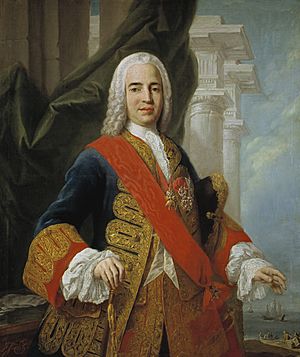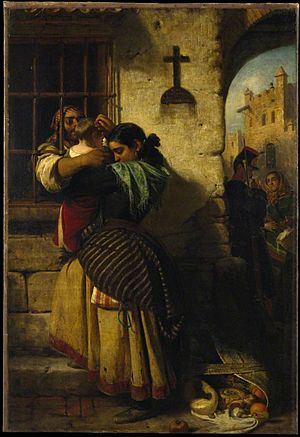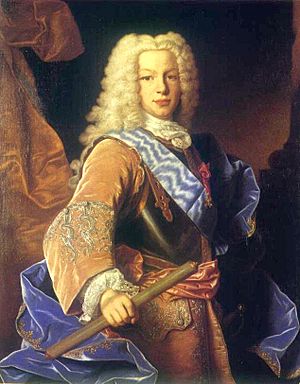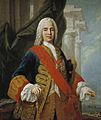Great Gypsy Round-up facts for kids
The Great Gypsy Round-up (called Gran Redada de Gitanos in Spanish) was a big, secret operation ordered by the Spanish Monarchy. On July 30, 1749, police and soldiers across Spain arrested most Roma living there. Many were held in prisons or forced to work. King Ferdinand VI of Spain approved this plan, and the Marquis of Ensenada organized it.
Before this event, Romani people in Spain faced many rules. A royal order from King Charles II in 1695 said they could only live in certain towns. Later, in 1717, another rule limited them to just 75 towns and areas. This was done to stop them from gathering in one place.
Historians like Nicolás Jiménez González say the 1749 Great Round-up was an early attempt to stop the Romani people from continuing their way of life in Spain. The goal was not to harm them immediately in prisons. Instead, authorities wanted to separate men and women, making it impossible for new Romani families to form. This would slowly cause the Romani population to disappear.
How the Round-up Was Planned

The plans for the round-up were kept very secret. Gaspar Vázquez Tablada, who was the Governor of the Council of Castile and a Bishop of Oviedo, helped create the first plans. A Jesuit priest named Father Francisco Rávago, who was King Ferdinand VI's confessor, also supported the idea. He believed it was a good thing to do.
The plan involved sending soldiers to towns where Romani people lived. Each group of soldiers had sealed instructions that they could only open just before the round-up in August. The soldiers were to surround Romani settlements. All adult Romani men who were healthy were to be sent away to work in naval shipyards, mines, prisons, or factories. Women and children were forced to work making clothes. Those who were too sick to travel would stay under military guard until they got better or died. The money to pay for this operation was supposed to come from taking the Romani people's homes and belongings.
The round-up happened differently in various towns. In Seville, the city gates were closed by the army to stop anyone from escaping. This caused a lot of worry among the general public, who didn't know what was happening. Special orders were made to prevent people from seeking safety in churches. It was also hard to decide who exactly was Romani, and sometimes this rule was used unfairly. For example, Romani people married to non-Romani people were often not arrested. Romani people who traveled a lot were also harder to catch.
In the end, about 9,000 Romani people were arrested. About 5,000 of them were let go three months later because their neighbors and local officials protested. The remaining 4,000, who didn't have community support, were slowly released starting in 1750. This process took eight years, and it's thought that about 500 of them died during this time.
Reversal of the Round-up
The arrests caused immediate anger and protests, especially for those Romani people who were well-known and part of their communities. Because of these protests, most of those arrested were released three months after the round-up. The remaining 4,000 were gradually set free from 1750 onwards. By 1763, the last hundred prisoners were officially pardoned and released by the King.
Images for kids
-
Marquis de la Ensenada, Royal Minister who organized the roundup.
See also
 In Spanish: Gran Redada para niños
In Spanish: Gran Redada para niños






